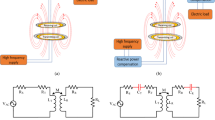Abstract
Wireless recharge of electric vehicles is an important field of research. Design of inductive power transfer systems involves the optimization of resonant coils coupled through mutually induced magnetic fields. Currently there is a big interest concerning both on optimization methods and on the research of innovative topologies able to maximize both power transfer and efficiency. In this work, authors proposed an innovative approach: resonant electric systems can be modelled as equivalent lumped mechanical models that can be optimized adopting conventional methods of modal analysis that are currently used to study mechanical vibrating systems. In particular, one of the main advantage of the proposed approach is the possibility of an intuitive physical interpretation of system behaviour. Proposed approach is applied to the study of some known Inductive Power Transfer topologies such as the series–series and the LCC ones. Application of the proposed bond-graph analogy with equivalent mechanical systems is used to propose some simple and effective design criteria for the optimal tuning of the over-cited coil topologies. Proposed methodologies are verified on benchmark test cases comparing obtained results respect to most recent conventional design methods proposed in literature.














Similar content being viewed by others

References
Society of Automotive Engineers (2016) Wireless power transfer for light-duty plug-in electric vehicles and automated charging and alignment methodology. http://standards.sae.org/wip/j2954/
Alfatihi S, Chihab S, Alj YS (2013) Intelligent parking system for car parking guidance and damage notification. In: 2013 4th international conference on intelligent systems modelling and simulation (ISMS). IEEE, pp 24–29
Kim D, Chung W, Park S (2010) Practical motion planning for car-parking control in narrow environment. IET Control Theory Appl 4(1):129–139 IET
Jiang K, Seneviratne LD (1999) A sensor guided autonomous parking system for nonholonomic mobile robots. In: Proceedings of the 1999 IEEE international conference on robotics and automation, vol 1. IEEE, pp 311–316
Budhia M, Covic GA, JT Boys (2011) Design and optimization of circular magnetic structures for lumped inductive power transfer systems. IEEE Trans Power Electron 26(11):3096–3108 IEEE
Bi Z, Kan T, Mi CC, Zhang Y, Zhao Z, Keoleian GA (2016) A review of wireless power transfer for electric vehicles: prospects to enhance sustainable mobility. Appl Energy 179(2016):413–425 Elsevier
Covic GA, Boys JT (2013) Inductive power transfer. Proc IEEE 101(6):1276–1289 IEEE
Zhang X, Ho SL, Fu WN (2011) Quantitative analysis of a wireless power transfer cell with planar spiral structures. IEEE Trans Magn 47(10):3200–3203
Bululukova D, Kramer M (2014) Application of existing wireless power transfer standards in automotive applications. In: 2014 international conference on connected vehicles and expo (ICCVE). IEEE, pp 863–864
Karnopp DC, Margolis DL, Rosenberg RC (1990) System dynamics: a unified approach. Wiley, New York. ISBN 0-471-62171-4
Borutzky W (2010) Bond graph methodology. Springer, Berlin. ISBN 978-1-84882-881-0
Pugi L, Malvezzi M, Allotta B, Banchi L, Presciani P (2004) A parametric library for the simulation of a Union Internationale des Chemins de Fer (UIC) pneumatic braking system. Proc Inst Mech Eng Part F J Rail Rapid Transit 218(2):117–132 SAGE
Pugi L, Conti R, Nocciolini D, Galardi E, Rindi A, Rossin S (2014) A tool for the simulation of turbo-machine auxiliary lubrication plants. Int J Fluid Power 15(2):87–100 Purdue
Pugi L, Galardi E, Carcasci C, Rindi A, Lucchesi N (2015) Preliminary design and validation of a real time model for hardware in the loop testing of bypass valve actuation system. Energy Convers Manag 92:366–384 Elsevier
He Q, Daqaq MF (2016) Electric load optimization of a nonlinear mono-stable duffing harvester excited by white noise. Meccanica 51:1027. https://doi.org/10.1007/s11012-015-0289-7
Awrejcewicz J, Calvisi ML (2002) Mechanical models of Chua’s circuit. Int J Bifurc Chaos 12(04):671–686
Chen MZ, Wang K, Zou Y, Chen G (2015) Realization of three-port spring networks with inerter for effective mechanical control. IEEE Trans Autom Control 60(10):2722–2727
Wheelers A (1982) Inductance formulas for circular and square coils. Proc IEEE 70:1449–1450
Wojda RP, Kazimierczuk MK (2013) Magnetic field distribution and analytical optimization of foil windings conducting sinusoidal current. IEEE Magn Lett 4:0500204
Ewins DJ (1984) Modal testing: theory and practice, vol 15. Research studies press, Letchworth
Zhong WX, Hui SYR (2015) Maximum energy efficiency tracking for wireless power transfer systems. IEEE Trans Power Electron 30(7):4025–4034
Kan T, Nguyen T, White J, Malhan R, Mi C (2017) A new integration method for an electric vehicle wireless charging system using LCC compensation topology: analysis and design. IEEE Trans Power Electron 32:1638–1650
Yang Y, Dai W, Liu Q (2015) Design and implementation of two-degree-of-freedom tuned mass damper in milling vibration mitigation. J Sound Vib 335:78–88
Li YW (2009) Control and resonance damping of voltage-source and current-source converters with \(LC\) filters. IEEE Trans Ind Electron 56(5):1511–1521
Allotta B, Pugi L, Bartolini F (2009) An active suspension system for railway pantographs: the T2006 prototype. J Rail Rapid Transit 223:15–29. https://doi.org/10.1243/09544097JRRT174
Author information
Authors and Affiliations
Corresponding author
Rights and permissions
About this article
Cite this article
Pugi, L., Reatti, A. & Corti, F. Application of modal analysis methods to the design of wireless power transfer systems. Meccanica 54, 321–331 (2019). https://doi.org/10.1007/s11012-018-00940-x
Received:
Accepted:
Published:
Issue Date:
DOI: https://doi.org/10.1007/s11012-018-00940-x


